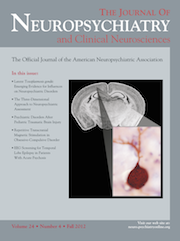Wernicke Encephalopathy in a Non-Alcoholic Patient With Metastatic CNS Lymphoma and New-Onset Occipital Lobe Seizures
To the Editor: A 51-year-old man with no psychiatric or alcohol use history was treated for high-grade B-cell lymphoma involving the bowel, liver, and bone marrow, achieving complete remission with systemic chemotherapy. Six months later, he developed severe headaches secondary to relapsed CNS lymphoma.
He presented with confusion, bilateral ophthalmoplegia, non-reactive pupils, and ptosis. MRI showed leptomeningeal enhancement along the temporal and occipital lobes bilaterally with adjacent parenchymal infiltration and expansion of the cavernous sinuses. On admission, high-dose intravenous methotrexate was initiated, and the psychiatry department was consulted because of concern for delirium. On mental status exam, he was noted to be confused, with florid visual hallucinations (seeing animals in his room, sparkles dancing on his skin, and the blood coursing through his veins).
Wernicke encephalopathy (WE) was suspected, and, after one dose of intravenous thiamine, he became fully oriented, and his symptoms of ophthalmoplegia improved, but visual hallucinations persisted. EEG showed epileptogenic activity over the left occipital region consistent with simple partial occipital lobe seizures. Visual hallucinations resolved with initiation of levetiracetam.
Discussion
Thiamine deficiency leads to breakdown of the blood–brain barrier, neuronal necrosis, and irreversible brain damage in susceptible areas, including the medial thalamus and periaqueductal gray matter.1 Despite thiamine administration, WE patients (as high as 80%) may progress to Korsakoff syndrome, a chronic condition characterized by anterograde amnesia and confabulations.2 Coma and death may ensue, with 17% mortality for untreated WE.2
The incidence of WE in the general cancer population is unknown. In one autopsy series, 8 of 24 patients with leukemia or lymphoma had pathologic findings suggestive of WE, none of which were recognized clinically.3,4 Cancer patients are at high risk of WE due to chronic malnutrition, chemotherapy-induced nausea and vomiting, and consumption of thiamine by rapidly-growing tumors such as hematological malignancies and sarcoma.1
Brain MRI is the imaging procedure of choice5 because of high specificity (93%), although it cannot exclude WE because of low sensitivity (53%). MRI findings in alcoholic patients with acute WE may reveal atrophy of the mamillary bodies, infratentorial regions, supratentorial cortex, and corpus callosum, whereas atrophic changes are generally absent in nonalcoholic patients.5
Diagnosis of WE is difficult in cancer patients because there are multiple reasons for confusional states, including hypoxia, infection, electrolyte imbalances, organ failure, opioid and sedative medications, chemotherapy, and brain and meningeal metastases.1 WE is a neurological emergency, and thiamine (500 mg 3 times daily) should be initiated immediately, either intravenously or intramuscularly, to ensure adequate absorption.4
Conclusions
Cancer patients are at high risk of developing WE, and it should be urgently treated with parenteral thiamine to prevent permanent neurologic damage and death. Thiamine prophylaxis should be considered in cancer patients to prevent WE.
1 : Wernicke’s encephalopathy: an underrecognized and reversible cause of confusional state in cancer patients. Oncology 2009; 76:10–18Crossref, Medline, Google Scholar
2 : The Wernicke-Korsakoff syndrome. A clinical and pathological study of 245 patients, 82 with post-mortem examinations. Contemp Neurol Ser 1971; 7:1–206Medline, Google Scholar
3 : Prospective neuropathologic study on the occurrence of Wernicke’s encephalopathy in patients with tumours of the lymphoid-hemopoietic systems. Acta Neuropathol Suppl 1981; 7:356–358Crossref, Medline, Google Scholar
4 : Anaphylaxis to thiamine (vitamin B1). Allergy 1997; 52:958–960Crossref, Medline, Google Scholar
5 : Usefulness of CT and MR imaging in the diagnosis of acute Wernicke’s encephalopathy. AJR Am J Roentgenol 1998; 171:1131–1137Crossref, Medline, Google Scholar



